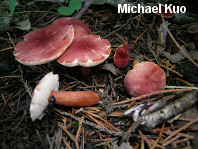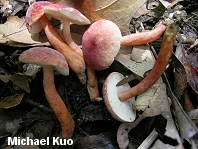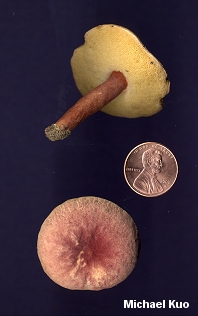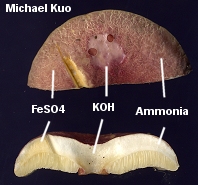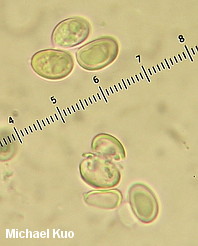| Major Groups > Boletes > Gyroporus > Gyroporus purpurinus |

|
Gyroporus purpurinus [ Basidiomycota > Boletales > Gyroporaceae > Gyroporus . . . ] by Michael Kuo For some reason, this is one of those mushrooms I always want to find--and only rarely can. I don't know how many times I have excitedly stooped down to pick it, only to discover that I am looking at one of several purplish Tylopilus species. Gyroporus purpurinus has yellowish spores, and therefore has a pore surface that eventually becomes pale yellow--while Tylopilus pore surfaces are typically pinkish by maturity. Why I get so excited about Gyroporus purpurinus, I don't know. It's a tiny little purplish red bolete, and I frankly have real doubts about its status as a separate "species"; not a lot, other than the color, separates it from Gyroporus castaneus, which is much more common and which, as its name suggests, is brown. Neither testing chemical reactions nor microscopic analysis provides a better means of separating the two mushrooms than simply observing that one is purplish red and the other is brown. Description: Ecology: Usually reported as mycorrhizal with hardwoods--but see the discussion on the page for Gyroporus castaneus, since Gyroporus purpurinus also seems to like path sides, embankments, and so on; growing alone, scattered, or gregariously; summer and fall; fairly widely distributed east of the Rocky Mountains, and reported in Mexico. Cap: 1.5-5 cm; convex, becoming broadly convex or nearly flat in age; dry; bald or slightly velvety; sometimes becoming somewhat wrinkled, or slightly cracked in age (like me, according to my friends); purplish red to purplish pink. Pore Surface: Whitish at first, becoming pale yellow; not bruising, or bruising slowly brownish; 1-2 circular to angular pores per mm; tubes to 5 mm deep. Stem: 3-5 cm long; 0.5-1 cm thick; more or less equal; dry; brittle; hollowing; colored like the cap; not bruising; not reticulate; basal mycelium white. Flesh: White; not staining on exposure. Odor and Taste: Not distinctive. Chemical Reactions: Ammonia negative on cap surface and flesh. KOH negative on cap surface; negative to yellowish on flesh. Iron salts negative on cap surface and flesh. Spore Print: Yellow. Microscopic Features: Spores 8-10 x 5-6 µ; smooth; ellipsoid; hyaline in KOH. Hymenial cystidia fusoid-ventricose; hyaline in KOH; to about 50 x 10 µ. Pileipellis a trichoderm with fusiform terminal elements 5-20 µ wide. REFERENCES: (Snell, 1936) Singer, 1945. (Singer, 1945; Snell & Dick, 1970; Smith & Thiers, 1971; Smith, Smith & Weber, 1981; Arora, 1986; Phillips, 1991/2005; Lincoff, 1992; Both, 1993; Horn, Kay & Abel, 1993; Bessette, Roody & Bessette, 2000.) Herb. Kuo 06289504, 09289620, 07230306, 06300709, 07050802, 07120810. This website contains no information about the edibility or toxicity of mushrooms. |
© MushroomExpert.Com |
|
Cite this page as: Kuo, M. (2013, December). Gyroporus purpurinus. Retrieved from the MushroomExpert.Com Web site: http://www.mushroomexpert.com/gyroporus_purpurinus.html |
